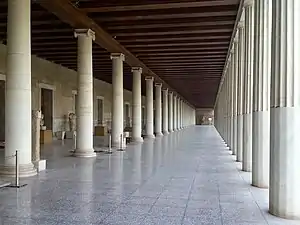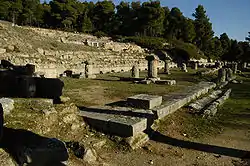
A stoa (/ˈstoʊə/; plural, stoas,[1] stoai,[1] or stoae /ˈstoʊ.iː/[2]), in ancient Greek architecture, is a covered walkway or portico, commonly for public use.[3] Early stoas were open at the entrance with columns, usually of the Doric order, lining the side of the building; they created a safe, enveloping, protective atmosphere.
This, an "open-fronted shelter with a lean-to roof", is the meaning in modern usage, but in fact the ancient Greeks "made no clear distinction in their speech" between these and large enclosed rooms with similar functions.[4]
Later examples were built as two stories, and incorporated inner colonnades usually in the Ionic style, where shops or sometimes offices were located. These buildings were open to the public; merchants could sell their goods, artists could display their artwork, and religious gatherings could take place. Stoas usually surrounded the marketplaces or agora of large cities and were used as a framing device.[5]
Other examples were designed to create safe, protective atmospheres which combined useful inside and outside space. The name of the Stoic school of philosophy derives from "stoa".[6]
Famous stoas

- Stoa Poikile, "Painted Porch", from which the philosophy Stoicism takes its name
- Stoa of Attalos
- Stoa Basileios (Royal Stoa)
- Stoa of Zeus at Athens
- Stoa Amphiaraion
- Stoa of the Athenians
- Royal Stoa of Herod's Temple
See also
References
- 1 2 "stoa", Oxford English Dictionary, 2nd Ed., 1989
- ↑ "stoa". Retrieved 2010-12-29.
- ↑ Baltzly, Dirk (2019), Zalta, Edward N. (ed.), "Stoicism", The Stanford Encyclopedia of Philosophy (Spring 2019 ed.), Metaphysics Research Lab, Stanford University, retrieved 2021-10-22
- ↑ Lawrence, 252
- ↑ Jeffrey Becker. "Introduction to Greek architecture". Khanacademy.org. Retrieved 10 March 2016.
- ↑ Sedley, David (2016), "Stoicism", Routledge Encyclopedia of Philosophy (1 ed.), London: Routledge, doi:10.4324/9780415249126-a112-1, ISBN 978-0-415-25069-6, retrieved 2021-10-22
- Lawrence, A. W., Greek Architecture, 1957, Penguin, Pelican history of art
External links
- YASOU
- . Encyclopædia Britannica (11th ed.). 1911.